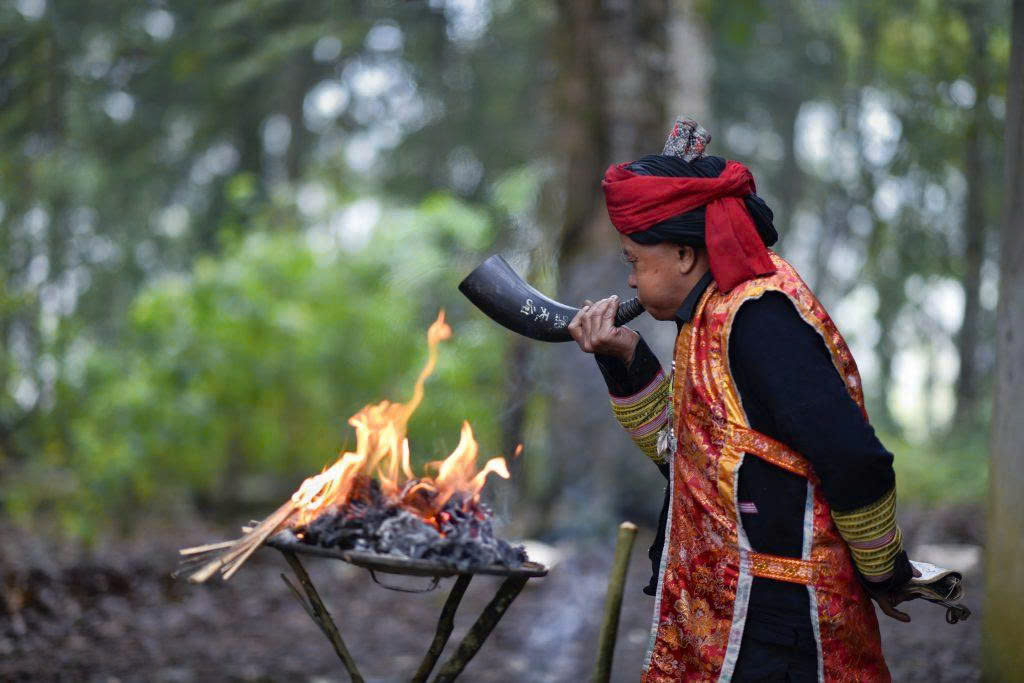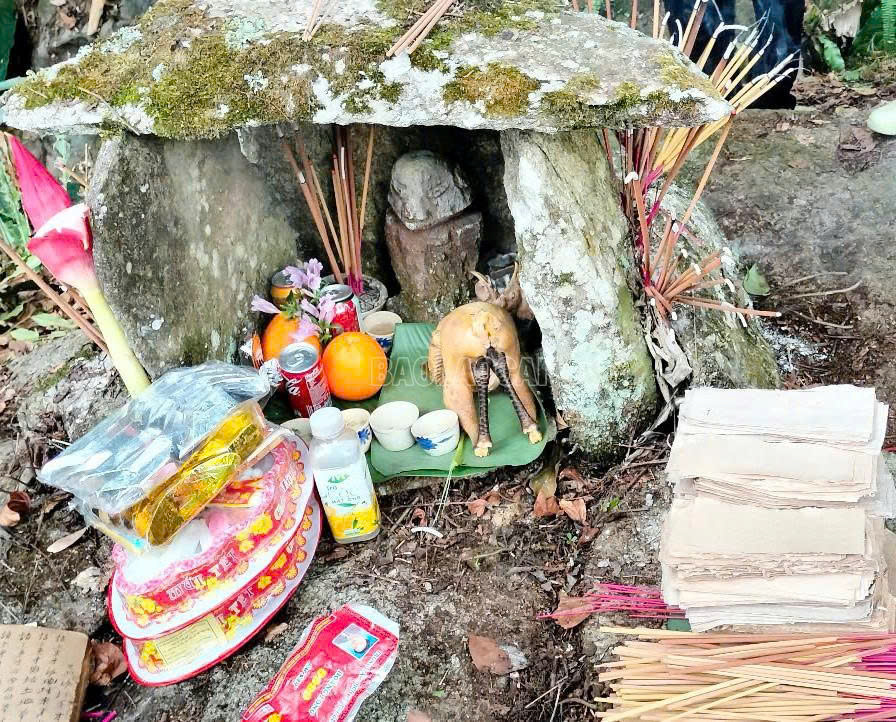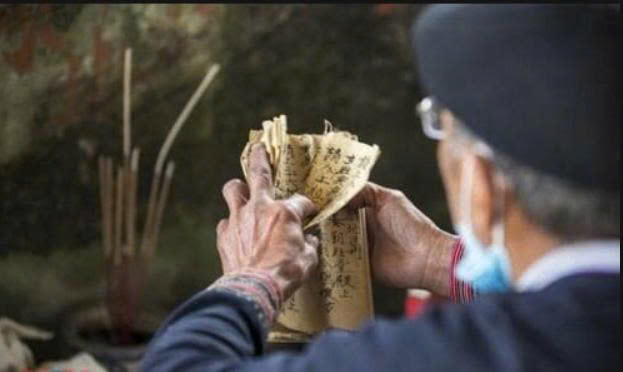Guardians of the Forest: Exploring the Red Dao’s Sacred Ceremony in Hoang Su Phi

Origins and Evolution of The Red Dao’s annual forest offering ritual
The forest worship celebration of the Red Dao people in Hoang Su Phi is not merely a spiritual ritual but also the crystallization of a long-standing tradition closely associated with the belief in the forest guardian spirit — the deity who protects the community and nature. According to oral legends, long ago, the ancestors of the Red Dao believed that every forest was overseen by a divine guardian, who maintained the balance of nature and protected humans from evil and dangers lurking in the wild.
A folk tale relates that when humans first began clearing new land and cutting down forests to make fields, the forest spirit became angry at this intrusion. To apologize and seek forgiveness, the Red Dao established the forest worship ceremony, offering sacred gifts to express gratitude and ask for protection. Since then, the forest worship ceremony has grown into an indispensable part of the spiritual and cultural life of the Red Dao people.
Over the centuries, despite many changes in life, the forest worship ceremony has been strictly preserved within the community. Traditional rituals — from preparing offerings, reciting prayers, to observing rules and related rites — have all been kept intact. Moreover, the ceremony serves as an occasion to pass on culture, language, and customs to the younger generation, helping to maintain the unique cultural heritage of the Red Dao people.
The Spiritual Space of the Red Dao Community in Hoang Su Phi
For the Red Dao community in Hoang Su Phi, the forest represents far more than a source of daily necessities like firewood, medicinal plants, and food. It is honored as a holy residence for spiritual forces and guardian deities. Habitants believe that every forest is overseen by its own divine protector, making these places sacred and strictly protected from activities such as tree cutting, hunting, or any harm.
The Forest Worship Ceremony – A Harmony Between Humans and the Divine

Every spring, the Red Dao community in Hoang Su Phi (Ha Giang province) holds a sacred Forest Worship Ceremony to honor the guardian spirits of the forest. This ceremony is performed to ask for favorable weather, abundant harvests, robust health, and safety from wild animals.
The ceremony is held in a sacred forest near the village, believed to be the dwelling place of powerful deities. Led by a shaman, villagers offer traditional items such as sticky rice cakes, chickens, and leaf-fermented corn wine.
Each of these offerings carries deep symbolic meaning: sticky rice cakes (or bánh chưng/bánh dày) made from glutinous rice represent the earth and sky as well as the abundance of the harvest, emphasizing the deep connection between people and the natural world. The sticky rice cakes, known as bánh chưng or bánh dày, represent the harmony between earth and sky and symbolize the abundance of the harvest, reflecting the deep connection. The corn wine, naturally fermented from corn and forest leaves, carries sacred meaning as it serves to invite and honor the presence of spirits and ancestors during the ceremony. Boiled chickens stand for vitality and strong life energy, embodying wishes for growth and divine protection. Additionally, carefully selected fruits, fresh flowers, and other traditional dishes are offered, each carrying hopes for good health, plentiful harvests, and overall well-being. The ritual site is carefully cleaned and prepared to ensure spiritual purity.
One particularly profound aspect of the ritual lies in its taboos: those not involved in the ceremony are strictly prohibited from entering the forest on that day. Moreover, no one is allowed to enter anyone else’s house throughout the entire day. After the ritual concludes, participants return home using only one designated path and are forbidden to wander or make detours. These regulations reflect deep reverence for spiritual customs and help preserve the sanctity of the ritual.
Throughout the year after the ceremony, the revered forest is safeguarded, ensuring no tree is felled, no wildlife disturbed, and the natural balance remains intact. This tradition not only symbolizes the spiritual beliefs of the Red Dao but also significantly supports forest conservation and the protection of native wildlife diversity.
Shamans as Messengers Between Earth and Spirit

Shamans (thầy cúng) play the role of spiritual intermediaries between humans and the deities. They are keepers of ancient knowledge, conducting the rituals and chanting invocations in the old Dao language. The involvement of a shaman expresses the Red Dao’s enduring connection to the spiritual world and aids in passing down their indigenous heritage.
Lessons in Sustainability from Indigenous Traditions
Forest worship is a testament to the Red Dao’s deep respect for nature and their sustainable way of life. Thanks to these cultural beliefs, the forests of Hoang Su Phi are preserved, exhibiting thick greenery and a wide range of species. These sacred groves are home to rare medicinal plants and wild animals, protected not by laws, but by cultural values.
Community Participation in Preserving Sacred Forests
The sacred forest is not protected by fences or surveillance, but by the collective will of the community.
Elders, who hold deep knowledge of rituals and taboos, play a vital role in teaching the younger generation about the importance of respecting nature and spiritual customs.
Children grow up hearing stories of the forest spirits, learning that even the smallest tree or spring may be guarded by unseen forces.
This time-honored tradition plays an important role in forest conservation, making protection a lifelong commitment rooted in the community and passed from generation to generation.
Sacred Forests as Living Museums of Biodiversity
In Hoang Su Phi, sacred forests are not only revered for their spiritual importance but also valued as natural sanctuaries rich in biodiversity. These safeguarded woodlands are home to a variety of healing plants, native flora, and rich animal life. Since the forests are fully protected from logging and hunting, the forests retain their untouched character, allowing the ecosystem to thrive naturally. Ecologists and researchers consider these sites invaluable for conserving genetic resources and gaining insight into native ecosystems. The Red Dao’s cultural practices, though deeply spiritual, offer a compelling example of grassroots conservation — one that modern environmental efforts can learn from.
Conclusion
In the rush of modern life, the forest worship practices of the Red Dao in Hoang Su Phi remind us that nature is not merely a resource – it is the spiritual essence of culture and community. If you ever visit Ha Giang, don’t miss the chance to witness this sacred ritual, where humans and nature join in a symphony of harmony and reverence.




.jpg)


